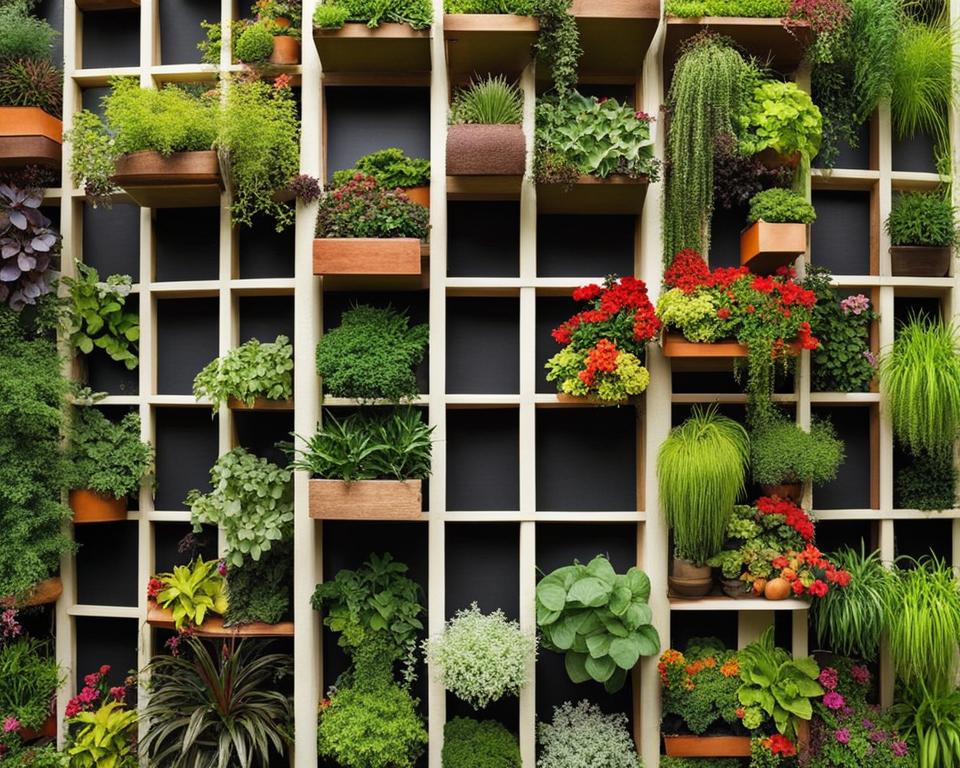Are you intrigued by the concept of vertical gardening? It’s a game-changer in the realm of urban horticulture and garden innovation, ideal for when you’re looking to maximize space and cultivate a green thumb. Imagine transforming your limited living quarters into a vibrant sanctuary. Vertical gardening allows you to do just that, using upwards growth to create a living tapestry of plants and edibles right where traditional gardens wouldn’t be plausible.
Whether you’re in a cozy apartment or a house with a petite yard, vertical garden design ideas can redefine your connection to nature. Say goodbye to the ‘flat’ norm of gardening; the vertical dimension is where your garden can truly bloom. Grow a mix of flowers, herbs, or even vegetables, climbing skyward along walls, fences, or custom-built frames. Vertical gardens are all about embracing creativity and strategic growing techniques to craft functional, beautiful spaces.
Key Takeaways
- Vertical gardening is a brilliant solution for urban dwellers with limited ground space.
- It ingeniously flips the axis of horticulture, unlocking new growing possibilities and maximizing verticality.
- Engage with various vertical garden design ideas to turn modest spaces into lush, productive landscapes.
- From aesthetic to edible, vertical gardens make it feasible to enjoy a range of plants in any environment.
- Discover the joys and benefits of this sustainable garden innovation, where every inch of space is a growing opportunity.
Introduction to Vertical Gardening
As living spaces become more compact, especially in urban areas, the ingenuity of vertical gardening brings a refreshing transformation to contemporary agriculture. This innovative approach aligns perfectly with modern sustainability goals, optimizing limited spaces to create pockets of greenery that cascade upwards. Before diving into the world of vertical gardens, it’s integral to understand its essence, history, and the multitude of advantages it has to offer.
Defining Vertical Gardening
At its core, vertical gardening is the practice of growing plants on a vertical surface, utilizing a variety of structures to enable upward growth. This contrasts sharply with traditional horizontal gardens, presenting an imaginative and space-savvy way to cultivate a diverse array of flora. If you’re wondering how to start vertical gardening, the process can be as simple as hanging planters on a wall or as complex as installing a green façade on a building.
History and Evolution
The concept of vertical gardening isn’t novel—it draws inspiration from ancient civilizations, such as the Hanging Gardens of Babylon. However, it has undergone a remarkable evolution, seamlessly integrating into modern architecture and lifestyles. Once a rarity, these living walls are now a signature trait of eco-friendly design, showcasing how historic techniques can be reinvented to suit contemporary needs.
The Benefits of Going Vertical
Vertical gardening is becoming increasingly popular for reasons that extend beyond its aesthetic appeal. The benefits of vertical gardening include better air quality, increased biodiversity, and the creation of calming, green-filled spaces even in the smallest urban dwellings. By adopting vertical gardening techniques, you can transform any barren wall or fence into a productive and vibrant garden, reaping the rewards of homegrown produce and a personal connection to nature.
- Space Efficiency: Optimizes underused vertical areas, turning walls and fences into productive spaces.
- Increased Yield: Facilitates a greater output within a reduced footprint, perfect for small urban lots or balconies.
- Accessibility: Often simplifies gardening chores, with less bending and reaching required, making it an ideal solution for individuals with mobility issues.
- Microclimate Control: Adds layers of plants that can regulate temperature, reducing the need for heating and cooling in adjacent indoor spaces.
What is Vertical Gardening and Its Advantages
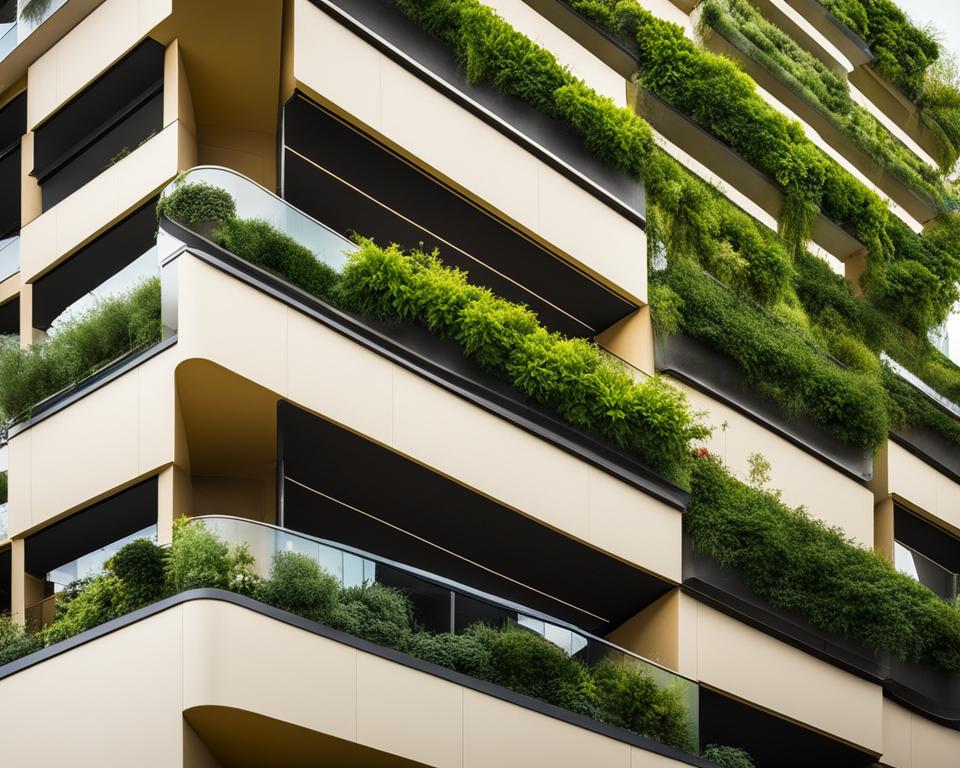
As you explore vertical vegetable gardening, you quickly discover it’s an innovative gardening technique designed for maximizing space. Unlike traditional horizontal layouts, this method elevates the cultivation experience—literally. You’ll see crops growing along walls, fences, and trellises, and these vertical assemblies can be as simple or sophisticated as you wish, from makeshift frames to advanced hydroponic systems.
This approach to horticulture is particularly advantageous for urban dwellers where ground real estate is at a premium. Vertical gardens make the most of your available vertical space, enabling the inclusion of plant life in compact living situations. Apartments, small yards, and balconies can become verdant environments rich with fruits, vegetables, and herbs. Certainly, there is a profound satisfaction in witnessing your walls bloom with life and your meals enriched by your harvest.
Here’s a look at the typical benefits you can expect from adopting vertical gardening in your own living space:
- **Increased Plant Growth Area**: Even a narrow alley can serve as a bountiful garden.
- **Aesthetic Improvement**: Transform bland spaces into stunning green tapestries.
- **Improved Air Quality**: Plants contribute to a fresher, cleaner atmosphere around your home.
- **Accessibility**: Tending to a vertical garden often requires less bending and stooping, making it easier on your back.
- **Heat Regulation**: Plants on exterior walls can provide insulation from heat, potentially reducing energy costs.
With the right tools and guidance, even novice gardeners can find success in vertical gardening. Now, let’s consider a simple comparison between traditional and vertical gardening:
| Gardening Method | Space Usage | Accessibility | Aesthetics | Yield Potential |
|---|---|---|---|---|
| Traditional | Horizontal; requires more ground area | May require more bending/stooping | Primarily functional | Dependent on plot size |
| Vertical | Vertical; optimizes limited space | Plants are at a more accessible height | Decorative and functional | Can be high due to vertical layering |
Imagine your kitchen window framed not just with your favorite spices but also with a lush cascade of tomatoes and lettuce. Such is the promise of vertical vegetable gardening, where design and utility unite in harmony. It’s an invitation to rethink the way you grow and interact with your own food, fostering a lifestyle that is as efficient as it is rewarding.
Maximizing Small Spaces with Vertical Gardens
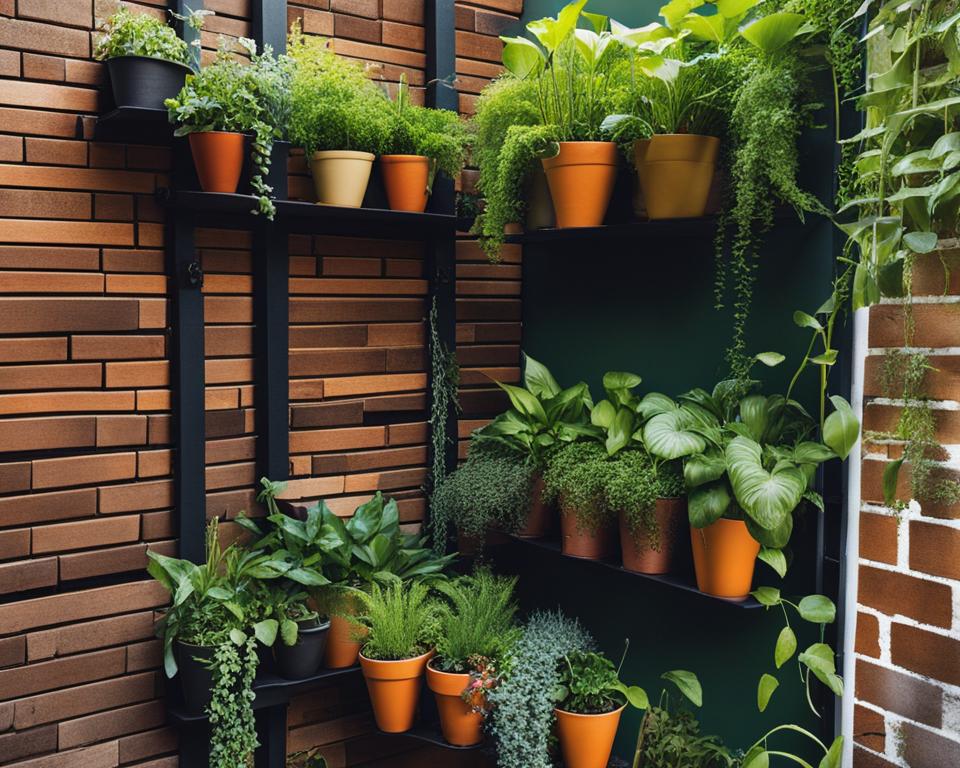
With urban living spaces shrinking by the day, it’s essential to find creative ways to bring nature into your home. Vertical gardening for small spaces presents a beautiful and functional solution, enhancing your environment without the need for expansive horizontal areas. Whether you’re an avid gardener or a green-thumb novice, DIY vertical gardening is an approach that’s both rewarding and accessible.
Designing for Limited Areas
When square footage is at a premium, the layout of your vertical garden becomes increasingly important. Crafting a vertical garden that suits your space and lifestyle does not require a large patio or garden plot. Instead, a small balcony or wall can be transformed into a thriving, leafy oasis. It’s all about making smart choices regarding placement and plants to ensure that every inch of your vertical area is used efficiently.
Vertical Gardening Techniques
There are numerous vertical gardening tips and techniques that can be employed to create lush, dangling gardens or sleek, wall-mounted installations. Ranging from simple hanging pots to sophisticated hydroponic systems, these methods are catered to suit the needs of any small-space gardener. DIY enthusiasts can repurpose pallets or create pocket gardens, while modular systems can be purchased for a quick and easy setup.
Choosing the Right Structures
Selecting the right structures is crucial for successful vertical gardening. It’s not just about aesthetics—it’s also about functionality and ensuring the health of your plants. Here is a comparison of some popular choices:
| Structure | Best For | Considerations |
|---|---|---|
| Wall-mounted planters | Herbs, succulents, and small flowers | Ensure wall can support weight; consider sunlight and water drainage |
| Trellises | Climbing plants and vines | Must be anchored securely; ideal for creating green walls |
| Freestanding towers | Strawberries, greens, and a variety of herbs | Portable and versatile; check for stable base |
| Stacked planters | Mixed use (flowers, herbs, greens) | Maximize space vertically; consider ease of watering |
By embracing vertical gardening for small spaces, you can reap the benefits of a full garden with just a fraction of the real estate. DIY vertical gardening not only maximizes space usage but also ignites creativity—allowing you to design a unique green retreat that flourishes skywards.
Benefits of Vertical Gardening at Home
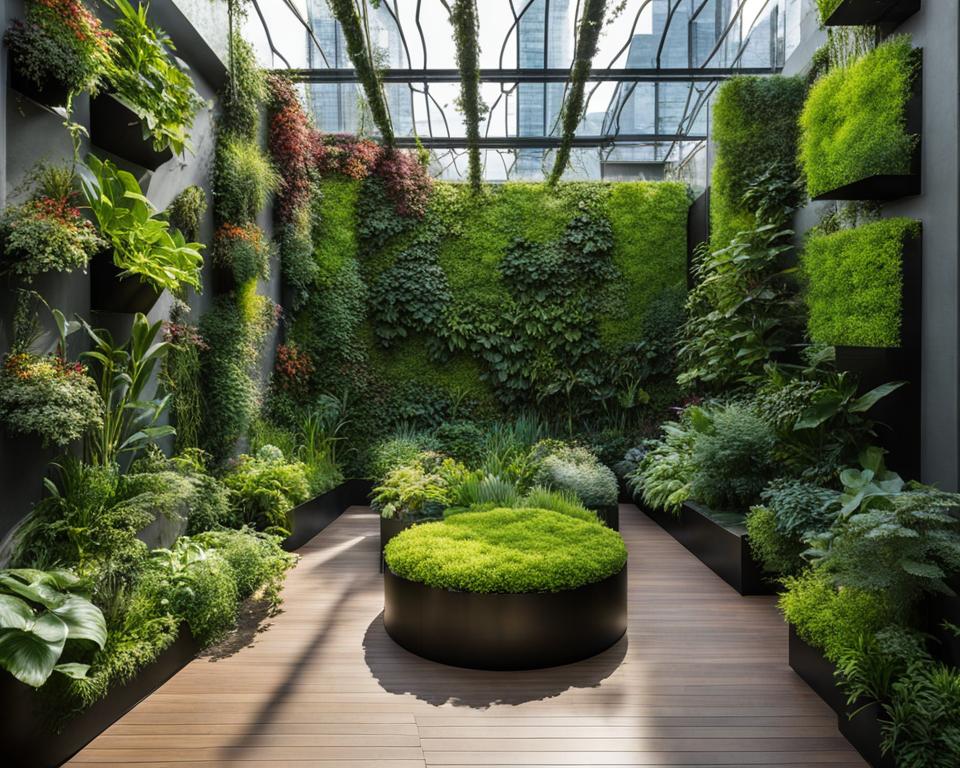
Gardening aficionados revel in the benefits of vertical gardening, a symbiosis of aesthetics, practicality, and sustainability right in the heartland of urban domesticity. By adopting a vertical stance, you can immerse in the vibrant hues and flavors of homegrown produce, a step towards a holistic and eco-friendly lifestyle.
Among the plethora of advantages, vertical gardening elevates air quality and induces a biophilic ambiance within the home. It invites a spectrum of beneficial insects, contributing to robust ecological diversity. Particularly when you’re pondering how to start vertical gardening, you’ll uncover the added joy of catering to a myriad of plants — from succulent strawberries to aromatic herbs — without the expanse of traditional gardening.
- Maximize limited space efficiently
- Enhance the aesthetic value of your home
- Improve home air quality with live plants
- Foster food independence with ease
- Promote biodiversity in urban settings
| Vertical Garden Benefit | Impact on Home | Practical Tips |
|---|---|---|
| Space-Saving Growth | Allows for lush gardens in smaller urban homes | Utilize vertical spaces like walls and balconies |
| Air Purification | Natural detoxification of indoor air | Include air-purifying plants such as ferns and spider plants |
| Homegrown Nutrition | Access to fresh, pesticide-free produce | Grow vegetables and herbs like tomatoes and basil |
| Eco-friendly Aesthetics | Green living walls contribute to a sustainable lifestyle | Integrate perennials and evergreens for year-round greenery |
Sink your roots into the verdant folds of vertical gardening and let your home blossom with the harmony of nature. Seize the reins of self-sufficiency and watch as your green wall turns harvests into health, compost into composure, and life into living art.
Creative Vertical Garden Design Ideas
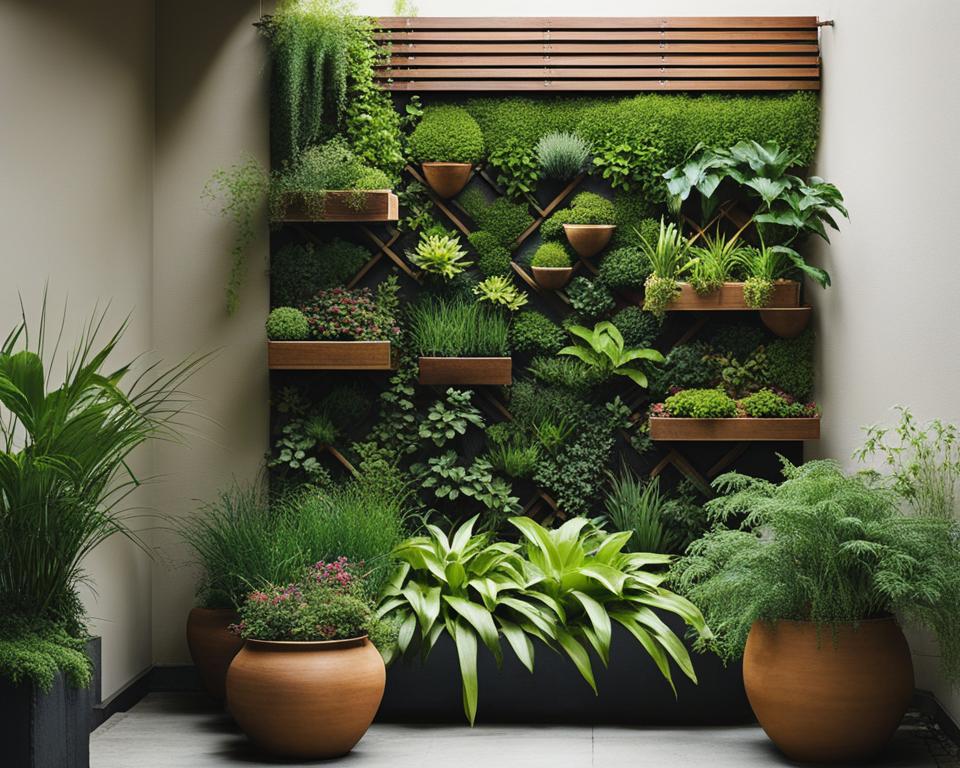
As urban spaces become more compact, it’s essential to think creatively about including greenery in your home. Vertical garden design ideas not only bring life to high-rise apartments and tiny backyards, but they also offer refreshing twists on traditional gardening. Let’s dive into some innovative concepts that can help you learn how to start vertical gardening with style and functionality.
Inspiring Examples of Vertical Gardens
Reflecting on the successes of those who’ve come before can ignite the spark of creativity for your vertical garden. Below is an image of a thriving vertical garden that optimizes space and radiates vitality. Notice how each plant is carefully chosen to create a tapestry of greenery that climbs upward, showcasing what can be achieved in even the smallest of spaces.
Incorporating Artistry and Functionality
When it comes to vertical gardens, thinking outside the pot is key. Imagine combining the lush, organic shapes of plants with the sharp, clean lines of modern architecture. By doing this, you craft a space that is both artistic and productive. Consider these factors as you plan your vertical garden:
| Design Element | Functional Benefit | Artistic Impact |
|---|---|---|
| Wall-mounted planters | Increases floor space | Creates a living artwork |
| Trellises with climbers | Supports plant growth vertically | Offers dynamic visual patterns |
| Stacked crates or shelves | Allows for diverse plant types | Adds structure and depth |
| Repurposed ladders | Facilitates modular gardening | Gives a rustic charm |
| Hanging baskets | Enables use of overhead space | Introduces variety in height |
Vertical garden design ideas are not just about layering plants on walls; they’re a blend of form and function, an ode to nature in the concrete jungle. As your curiosity about how to start vertical gardening deepens, let innovation be your guide, and allow your vertical space to flourish.
Guide to Vertical Vegetable Gardening
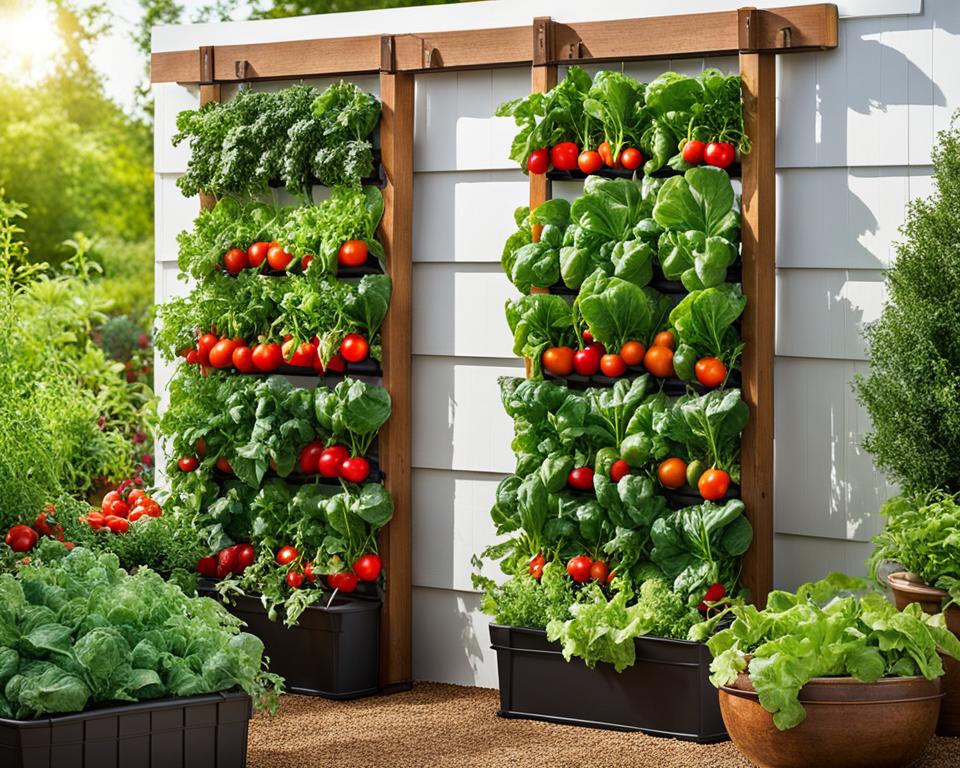
With trends shifting towards sustainability, vertical vegetable gardening emerges as a visionary method to foster homegrown vegetables within the constraints of modern living spaces. Whether you possess a compact balcony or a tiny backyard, vertical gardening utilized every square inch your area has to offer, making it an optimal solution for urban homes craving a personal touch of nature.
Diving into vertical gardening allows you to grasp the full potential of your vertical space, transforming bland walls into an efficient, sustainable food source. To embark on this green journey, you’ll need to understand the specifics of plant selection, caring, and structuring your garden to reap the best possible harvest.
To begin, you’ll need to assess the conditions of your available space—consider factors like sunlight exposure, climate, and ease of access. These parameters are crucial for choosing the right vegetables that will thrive in your vertically inclined garden.
- Leafy greens like lettuce and spinach that require moderate light, are prime candidates for vertical gardens with partial shade.
- Herbs such as basil, thyme, and mint are also excellent choices for their adaptability and modest space requirements.
- For those who boast sunnier spots, tomato vines and strawberry plants will not only provide fruitful yields but also add a splash of vibrant color to your vertical display.
Moreover, the incorporation of the right structures is vital. From simple trellises to sophisticated hanging planters and tiered systems, each plays a role in the success of your garden.
| Vertical Structure | Pros | Cons | Ideal Plants |
|---|---|---|---|
| Wall-Mounted Planters | Space-efficient, easy to install | Limited growth room for root systems | Herbs, lettuce, edible flowers |
| Trellises and Climbing Frames | Excellent for vining plants, decorative | Requires training and pruning | Peas, beans, cucumbers |
| Tiered Shelves | Good sunlight distribution, movable | Watering can be uneven | Small root vegetables, aromatic herbs |
When your vertical vegetable garden is up and running, consistent care is key—this includes regular watering, pest control, and ensuring that your plants receive the essential nutrients they need. Automated drip irrigation systems and vertical composting can optimize your efforts, leading to a bountiful harvest.
Whether you’re an avid gardener seeking innovative methods or a city dweller looking to add some green to your view, vertical vegetable gardening is an enchanting way to enhance your living space with health, taste, and sustainability.
How to Start Vertical Gardening
Embarking on your vertical gardening adventure requires careful planning and some creative thinking. Vertical gardens not only save space, but they also add a living beauty to your environment, whether it be at home or in a community space. With the right vertical gardening techniques and DIY vertical gardening tips, anyone can transform a mundane wall or fence into a lush and productive vertical garden.
Choosing Suitable Plants for Vertical Growth
Selecting the right plants is the first essential step in how to start vertical gardening. Some species are naturally inclined to thrive in vertical environments. Look for climbers like ivy or jasmine, vegetables such as tomatoes and cucumbers, or herbs like basil and mint. Each of these plants has a root system that’s conducive to vertical growth, ensuring a successful and dynamic garden.
Building or Purchasing Vertical Structures
Once you’ve picked out your plants, you’ll need to think about support structures. These can be anything from trellises and climbing frames to pocket planters and hanging pots. If you’re handy, constructing your own structure can be a fulfilling DIY vertical gardening project. Alternatively, there are many products available that are designed for vertical gardening, suitable for a range of spaces and budgets.
Soil and Watering Considerations for Vertical Gardens
The health of your vertical garden is highly dependent on soil quality and watering techniques. Use a potting mix that’s light yet nutrient-rich to ensure your plants have all they need to grow upwards. Water presents a unique challenge in vertical gardens as gravity can cause uneven distribution. Drip irrigation or self-watering planters are excellent solutions, providing consistent moisture without overwatering or dry spots.
DIY Vertical Gardening Tips and Tricks
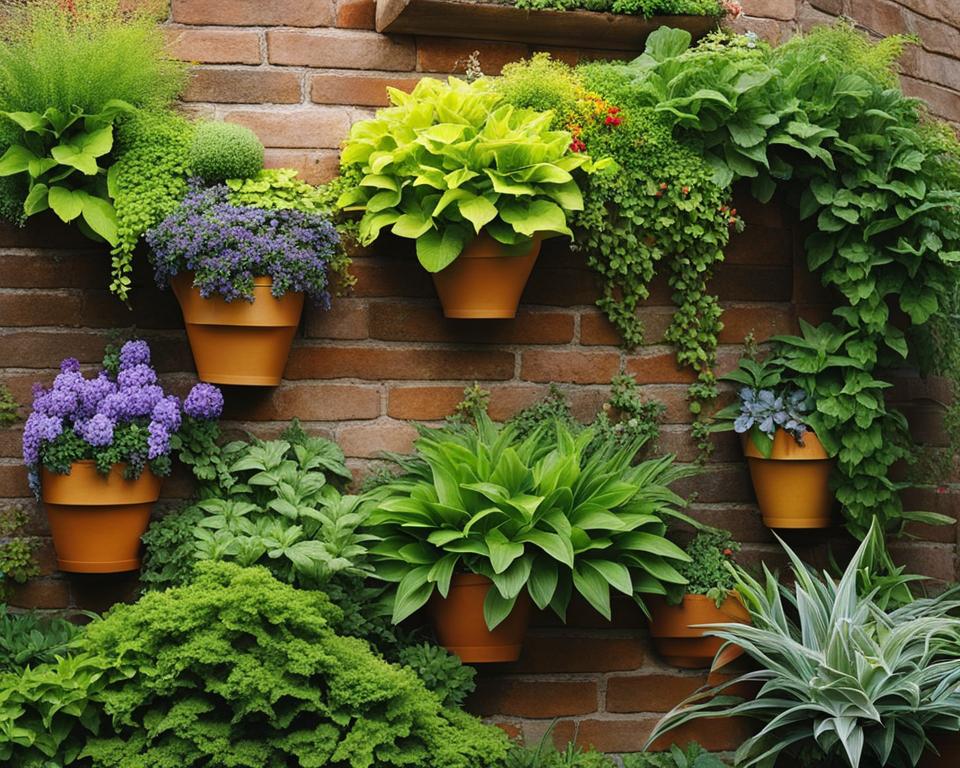
Embracing DIY vertical gardening means adopting an innovative approach to greener living, where you transform your living space with creative gardening solutions. Here’s a helpful compilation of tips to enhance your gardening experience and foster lush growth in your vertical space.
Starting Off: Begin with selecting plants that thrive vertically, like climbing vines or herbs, and consider varieties that work well in your climate zone. Next, use recycled materials such as old shelves, pallet wood, or metal frames to construct your vertical supports, adding a personal and eco-friendly touch to your garden.
Irrigation: For watering, incorporate a drip irrigation system into your design for consistent moisture without overwatering. This method saves time and conserves water, making it a perfect match for the vertical gardener keen on sustainability.
Nutrition and Care: Use quality potting mix and provide regular nourishment tailored to your plant’s needs. Being attentive to pruning and pest control will keep your garden healthy and productive. Here’s a breakdown of the essential aspects to consider:
| Aspect | Tip | Why It’s Important |
|---|---|---|
| Structure | Use sturdy materials; ensure adequate plant support. | Prevents sagging and damage; promotes healthy plant growth. |
| Plant Choice | Select plants suitable for vertical growth and your climate. | Ensures longevity and reduces maintenance. |
| Watering | Set up a drip irrigation system. | Efficient water use; prevents over or under-watering. |
| Soil | Use nutrient-rich, well-draining soil. | Provides a solid foundation for plant health. |
| Maintenance | Regularly check for pests and prune as necessary. | Encourages robust growth and prevents disease. |
By employing these vertical gardening tips, your vertical garden will not only save space but will become a focal point of beauty and productivity. Remember, the key to a successful DIY vertical garden is consistency and creativity. Let your garden be a reflection of your ingenuity and commitment to sustainable living.
Conclusion
The vertical gardening movement is indeed taking root across urban landscapes, transforming them into thriving canvases of foliage and vibrant life. As we witness the evolution of cityscapes, the integration of vertical garden design ideas showcases the undeniable benefits of vertical gardening—an oasis in a concrete jungle.
Transforming Urban Landscapes
What once began as an innovative solution to gardening in tight spaces has now become a pivotal element in urban design. Green walls and edible vertical installations are not only becoming more common but are also inspiring communities to rethink their relationship with nature.
The Future of Vertical Gardening
Futuristic cities teeming with vertical gardens point towards a greener, more sustainable model of living. With every vertical garden, we plant the seeds for a future where high-density living does not compromise green spaces but instead, enhances them.
Joining the Green Movement
Your involvement in creating or supporting a vertical garden contributes to a larger, global effort toward environmental stewardship. By leveraging vertical spaces, you become an integral part of this transformative green movement, promoting ecological balance and well-being.
| Aspect of Vertical Gardening | Benefits | Impact on Urban Living |
|---|---|---|
| Space Efficiency | Maximizes limited areas | Enables urban agriculture in compact spaces |
| Air Quality Improvement | Acts as a natural air purifier | Contributes to healthier city environments |
| Biodiversity | Supports a variety of plant species | Encourages a habitat for pollinators |
| Aesthetic Appeal | Enhances visual interest | Transforms building facades and public spaces |
Additional Resources
As you continue your vertical gardening journey, expanding knowledge and refining techniques are vital in maximizing garden potential. Resources such as “The 7-Day Vertical Garden Blueprint” provide an extensive guide to vertical gardening that can elevate your gardening prowess. These compendiums are instrumental, offering insights that cater to a spectrum of gardeners, from those just beginning to sow their first seeds to seasoned green thumbs looking to innovate further.
The leap from learning to implementing vertical gardening can be vast, but with the right information at your fingertips, you can craft a haven that is not only efficient in space usage but also abundant in yields. A reliable resource can act as your roadmap, demystifying the complexities of this gardening methodology and ensuring that your endeavors result in success.
Choosing to peruse these materials means embracing a community of like-minded individuals all aiming to harness the essence of nature within their homes. Engage with these guides to deepen your understanding, and let them inspire you to nurture a thriving, sustainable vertical garden that becomes a centerpiece of your sustainable living practices.
FAQ
What is Vertical Gardening?
Vertical gardening is an innovative gardening method that involves growing plants on a vertically inclined surface, such as trellises, walls, or towers. It maximizes usable space by taking advantage of the vertical plane, making it ideal for urban settings or areas with limited ground space.
What are the Benefits of Vertical Gardening?
The benefits of vertical gardening include space efficiency, increased plant yield, improved air quality, and enhanced biodiversity. It enables the cultivation of plants in tight spaces, encourages self-sufficiency through homegrown produce, and contributes to a greener, more sustainable environment.
How Long has Vertical Gardening Been Around?
Vertical gardening is not a new concept; it has historical roots but has gained modern popularity due to its practical application in urban environments and its alignment with sustainable living trends. It has evolved to integrate innovative design and technology, making it more accessible than ever.
How Can I Design a Vertical Garden in a Limited Space?
Designing a vertical garden in a limited space involves selecting the right structures, such as wall-mounted planters, hanging baskets, or freestanding vertical frames, and choosing plant varieties that thrive in vertical conditions. Creativity and planning are key to maximizing the potential of small areas.
What Techniques Are Used in Vertical Gardening?
Vertical gardening techniques range from simple methods like using climbing plants on trellises to more sophisticated systems like modular wall planters, pocket gardens, and hydroponic towers. Key techniques include proper plant selection, efficient watering solutions, and regular maintenance.
Which Structures Should I Choose for My Vertical Garden?
The structures for your vertical garden depend on the available space, type of plants, and personal preference. Options include trellis systems, vertical planting pockets, wall planters, stacked containers, and purpose-built vertical gardening frames that suit diverse aesthetics and functional needs.
How Do I Choose Suitable Plants for Vertical Growth?
When choosing plants for vertical growth, consider species that naturally climb or can be trained to grow upwards, as well as plants with shallow root systems. Ideal candidates include vines, ferns, succulents, and many vegetables and herbs that adapt well to vertical conditions.
Can I Grow Vegetables in a Vertical Garden?
Yes, vertical vegetable gardening is entirely possible and can be highly productive. You can grow a variety of vegetables such as tomatoes, cucumbers, peas, peppers, leafy greens, and herbs. Using vertical space for vegetables is a great way to maximize yield within small areas.
What DIY Tips Are There for Vertical Gardening?
DIY tips for vertical gardening include using recycled materials for planters, experimenting with homemade trellis or support structures, employing drip irrigation systems for watering, and regularly checking for the unique needs of vertical plants, such as pruning and pest control.
How Do I Maintain Soil and Water in My Vertical Garden?
Maintaining soil and water in a vertical garden involves ensuring proper drainage and soil moisture levels, often achieved through the use of well-draining soil mixtures and frequent, controlled watering systems like drip irrigation to keep plants hydrated without overwatering.
What are Some Creative Vertical Garden Design Ideas?
Creative vertical garden design ideas include living walls with patterned plantings, artistic trellis designs, quirky repurposed item planters, stackable planter systems, and the integration of edible plants amongst ornamentals for both beauty and functionality.
How is Vertical Gardening Transforming Urban Landscapes?
Vertical gardening is transforming urban landscapes by making use of vertical spaces, which were previously neglected. It revitalizes city environments by adding greenery, supports local ecosystems, provides fresh produce in food deserts, and enhances the aesthetics of built environments.
What’s the Future of Vertical Gardening?
The future of vertical gardening is bright, with potential for further technological advancements, more widespread adoption in urban planning, increased community involvement, and a stronger focus on sustainable agriculture and self-sustaining ecosystems within cities.
How Can I Start My Own Vertical Garden?
To start your own vertical garden, identify the location with adequate sunlight, select suitable plants and structures that fit your space and resources, and get informed on the proper maintenance practices. Utilize DIY kits or professional systems suited to your skill level and available space.
Where Can I Find Additional Resources on Vertical Gardening?
Additional resources on vertical gardening can be found in books like “The 7-Day Vertical Garden Blueprint,” gardening workshops, online platforms, community groups, and websites dedicated to urban gardening and sustainability. These resources offer valuable information on starting and maintaining vertical gardens.
Source Links
- https://medium.com/@mlcgardenmaintenance/revolutionize-your-space-mastering-vertical-gardening-for-a-lush-homegrown-oasis-47e82a713296
- https://www.coohom.com/article/unleashing-the-beauty-of-exotic-plants-through-vertical-gardening-in-your-backyard
- https://howtogroweverything.com/vertical-gardening-gardening-explained/

